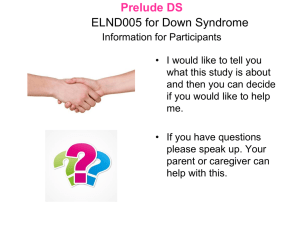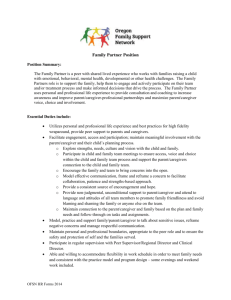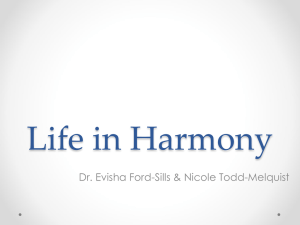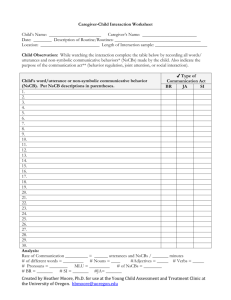Interpersonal Relationships.DOC
advertisement
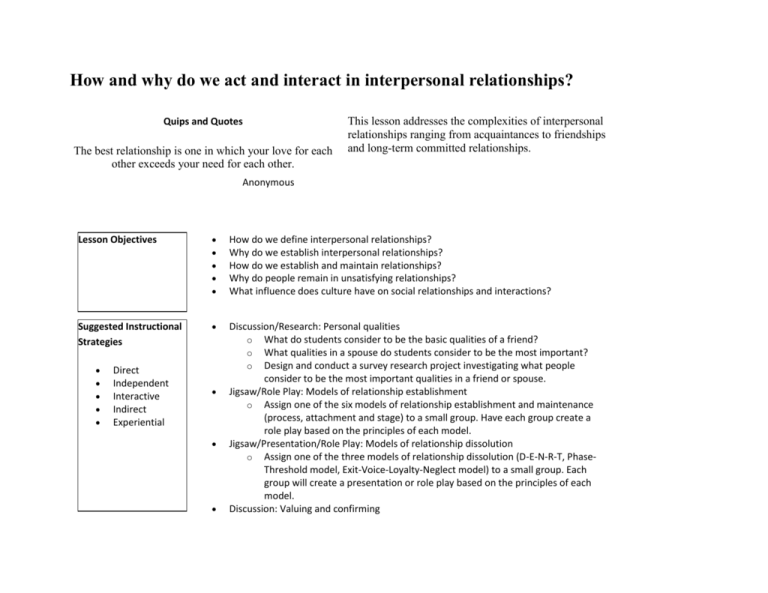
How and why do we act and interact in interpersonal relationships? Quips and Quotes The best relationship is one in which your love for each other exceeds your need for each other. This lesson addresses the complexities of interpersonal relationships ranging from acquaintances to friendships and long-term committed relationships. Anonymous Lesson Objectives How do we define interpersonal relationships? Why do we establish interpersonal relationships? How do we establish and maintain relationships? Why do people remain in unsatisfying relationships? What influence does culture have on social relationships and interactions? Suggested Instructional Strategies Discussion/Research: Personal qualities o What do students consider to be the basic qualities of a friend? o What qualities in a spouse do students consider to be the most important? o Design and conduct a survey research project investigating what people consider to be the most important qualities in a friend or spouse. Jigsaw/Role Play: Models of relationship establishment o Assign one of the six models of relationship establishment and maintenance (process, attachment and stage) to a small group. Have each group create a role play based on the principles of each model. Jigsaw/Presentation/Role Play: Models of relationship dissolution o Assign one of the three models of relationship dissolution (D-E-N-R-T, PhaseThreshold model, Exit-Voice-Loyalty-Neglect model) to a small group. Each group will create a presentation or role play based on the principles of each model. Discussion: Valuing and confirming Direct Independent Interactive Indirect Experiential o Making Connections Resources In what ways do people demonstrate confirming and valuing behaviours to their friends? o Using the concept of the Medicine Wheel, discuss confirming and valuing behaviours and attitudes for each of our physical, mental, emotional and spiritual aspects. Discussion: Rules in relationships o What rules do students have for these different types of relationships: friendship, intimate, family, business, athletic or social? Consensus Decision Making: Relationships o Why do people establish relationships? o Is intimacy, rewards or equity the most important reason why people establish relationships? Discussion: Intimacy o Research intimacy, bonding and teams/groups/clubs. o How can intimacy be achieved through technology? Can Internet relationships survive? How do chat lines promote or hinder intimacy? What are the effects of relationship breakdowns? How does divorce impact on fathers, mothers and children? Curriculum Support Materials: The Medicine Wheel Interactions : Dear Pat, “Curious in Coronach” Lesson 4.3: Teacher Information How do we define interpersonal relationships? Long term relationships can be described in one of two ways: Exchange relationships are governed by the need for equity or an equal ratio of rewards and costs. In these types of relationships, o We like to be repaid immediately for our favours. o We feel exploited when our favours are not returned. o We keep track of who is contributing what to the relationship. o Being able to help the other person has no effect on our mood. Communal relationships are those in which the people's primary concern is being responsive to the other person's needs. In these types of relationships, o We do not like to be repaid immediately for our favours. o We do not feel exploited when our favours are not repaid. o We do not keep track of who is contributing what to the relationship. o Being able to help the person puts us in a good mood (Aronson et al., 1994, p. 404). Why do we establish relationships? Intimacy Dimensions of intimacy: Physical intimacy begins with attachment during infancy and is demonstrated by hugs, kisses, and physical closeness. Intellectual intimacy involves the exchange of important ideas, values and beliefs. Emotional intimacy involves the exchange of important feelings. Shared activities can include everything from working side-by-side at a job to meeting regularly for exercise workouts (Adler et al., 2001, p. 325) Rewards Intimacy can be satisfying, but it is not the only payoff that drives us to seek out and stay in relationships. Some social scientists have argued that all relationshipsboth personal and impersonalare based on a semi-economic model called social exchange theory. This approach suggests that we often seek out people who can give us rewardseither tangible or emotionalthat are greater than or equal to the costs we encounter in dealing with them. Social exchange theorists define rewards as any outcomes we desire. A simple formula captures the social exchange theory for why we form and maintain relationships: Rewards - Costs = Outcome According to social exchange theory, we use two standards in arriving at a judgement or decision: Comparison level are standards of what behaviours are acceptable; and comparison level of alternatives refers to a comparison between the rewards received in the present situation versus other rewards that could be expected to receive in others. Foa (1971) proposes that in a social exchange model of relationships, there are six interpersonal resources that can be exchanged: love, status, information, money, goods and services (Alcock et al., 1998, p. 218). Equity theory Some researchers have criticized social exchange theory for ignoring an essential variable in relationships: the notion of fairness, or equity. Equity theorists argue that people are not just out to get the most rewards for the least cost; they are also concerned about equity in their relationships, wherein the rewards and costs they experience and the contributions they make to the relationship are roughly equal to the rewards, costs and contributions of the other person (Aronson et al., 1994, p. 395). Confirming and Valuing Communication climate, or the emotional tone of a relationship, is the key to positive relationships. A climate doesn't involve specific activities as much as the way people feel about each other as they carry out those activities. The tone of a relationship is shaped by the degree to which people believe themselves to be valued by one another. Social scientists use the term confirming to describe messages that convey valuing (Adler et al., 2001, p. 389). How do we establish and maintain relationships? Process Models Rules Argyle and Henderson (1984) have conducted many studies looking at the rules people use in different types of relationships. By rules, they mean shared opinions or beliefs about what should or should not be done. According to Argyle and Henderson the two major functions of rules are to regulate behaviour in order to minimize potential sources of conflict, and to check on the exchange of rewards that motivate people to stay in relationships. Their research has uncovered rules that are thought to apply to all or most types of relationships, such as respecting other people's privacy, not discussing what has been said in confidence and being emotionally supportive. Additional rules apply in particular types of relationships. Argyle and Henderson's research indicates that relationships fall into clusters, with similar rules applying within a particular cluster. One such cluster includes spouse, sibling and close friends, whilst another includes doctor, teacher and boss. Deception is probably the most important rule that should not be broken. However, what counts as deception will depend on the nature of the relationship: if we cannot trust a friend or a partner, then the relationship is almost certainly doomed (Gross and McIlveen, 1998, p. 480). Filter Theory According to Kerckhoff and Davis (1962), relationships pass through a series of filters. They base this claim on a comparison between short-term couples (less than 18 months) and long term couples. Initially, similarity of sociological (or demographic) variables (such as ethnic, racial, religious and social class groups) determines the likelihood of people meeting in the first place. To some extent, our choice of friends and partners is made for us because the field of availables (the range of people who are realistically, as opposed to theoretically, available for us to meet) is reduced by social circumstances. The next filter involves people's psychological characteristics and, specifically, agreement on basic values. Kerckhoff and Davis found this was the best predictor of a relationship becoming more stable and permanent. Thus, those who had been together for less than 18 months tended to have stronger relationships when the partners’ values coincided. With couples of longer standing, though, similarity was not the most important factor. In fact, complementarity of emotional needs was the best predictor of a longer term commitment, and this constitutes the third filter (Gross and McIlveen, 1998, p. 486). Attachment Models Ainsworth (1978) discovered that infants form one of three basic attachments to the caregiver. The crucial feature determining the quality of attachment is the caregiver’s sensitivity, or the quality of response to the baby’s needs. The sensitive caregiver sees things from the baby’s perspective, correctly interprets its signals, responds to its needs, and is accepting, cooperative and accessible. By contrast, the insensitive caregiver interacts almost exclusively in terms of their own wishes, moods and activities. Ainsworth’s research indicated that sensitive caregivers have babies that are securely attached, whereas insensitive caregivers have insecurely attached babies. The insecurely attached babies were either anxious-avoidant or anxious-resistant (Gross and McIlveen, 1998, p. 329). See chart that follows. Category Anxious-avoidant Sample(%) 15 Typical behaviour: Baby largely ignores caregiver. Play is little affected by whether caregiver is present or absent. No or few signs of distress when caregiver leaves, and actively ignores or avoids caregiver on return. Distress is caused by being alone, rather than being left by the caregiver. Can be as easily comforted by a stranger as by the caregiver. In fact, both adults are treated in a very similar way. Securely attached 70 Typical behaviour: Baby plays happily while the caregiver is present, whether the stranger is present or not. Caregiver is largely ‘ignored’ because the baby trusts that care will be provided if needed. Clearly distressed when caregiver leaves and play is considerably reduced. Seeks immediate contact with caregiver on return, is quickly calmed down and resumes play. The distress is caused by the caregiver’s absence, not being alone. Although the stranger can provide some comfort, stranger and caregiver are treated very differently. Anxious-resistant 15 Typical behaviour: Baby is fussy and wary while the caregiver is present. Cries a lot more and explores much less than other two types and has difficulty in using caregiver as a safe base. Very distressed when caregiver leaves, seeks contact on return, but simultaneously shows anger and resists contact (may approach caregiver and reach out to be picked up, but then struggles to get down again). This demonstrates the baby’s ambivalence towards the caregiver. Does not return readily to play. Actively resists stranger's efforts to make contact. Stage Models Knapp’s Model One of the best known models of relational stages was developed by Mark Knapp (1992), who broke down the rise and fall of relationships into 10 stages, contained in the broad phases of “coming together” and “coming apart”. The following stages are especially descriptive of intimate, romantic relationships and close friendships. InitiatingExpressing interest in making contact and showing that you are the kind of person worth getting to know. ExperimentingThis stage involves uncertainty reduction, or the process of getting to know others by gaining more information about them. IntensifyingInterpersonal relationships now begin to emerge. Feelings about the other person are now openly expressed, forms of address become more familiar, commitment is now openly expressed, and the parties begin to see themselves as “we” instead of separate individuals. IntegratingIdentification as a social unit. Social circles merge. Partners develop unique, ritualistic ways of behaving. Obligation to the other person increases. Some personal characteristics are replaced and we become different people. BondingThe parties make symbolic public gestures to show society that their relationship exists (rings, tokens, marriage). DifferentiatingThe need to re-establish separate identities begins to emerge. The key to successful differentiation is maintaining a commitment to the relationship while creating the space for autonomy and individuality. CircumscribingCommunication between the partners decreases in quantity and quality. It involves a certain amount of shrinking of interest and commitment. StagnatingNo growth occurs. Partners behave toward each other in old, familiar ways without much feeling. AvoidingThe creation of physical, mental and emotional distance between the partners. TerminationIn romantic relationships the best predictor of whether the parties will become friends is whether they were friends before their emotional involvement (Adler et al., 2001, p. 335). Stimulus-Value-Role Theory Murstein (1987) sees relationships proceeding from a stimulus stage, in which attraction is based on external attributes (such as physical appearance), to a value stage in which similarity of values and beliefs becomes more important. The comes a role stage, which involves a commitment based on successful performance of relationship roles such as husband and wife. Although all these factors have some influence throughout a relationship, each one assumes its greatest significance during one particular stage (Gross and McIlveen, 1998, p. 486). Levinger's Theory For Levinger (1988) relationships pass through five stages rather than the three proposed by Murstein. These are: acquaintance or initial attraction, building up the relationship, consolidation or continuation, deterioration and decline, and ending. At each stage, there are positive factors that promote the relationship's development and corresponding negative factors that prevent its development or cause its failure (Gross and McIlveen, 1998, p. 486). What are the levels of relationship maturity? A desirable goal is to develop a mature identity and have positive, close relationships with others. Kathleen White (1987) has developed a model of relationship maturity that includes this goal as its highest level. Individuals are described as moving through three levels of relationship maturity: self-focused, role-focused, and individuated-connected. The self-focused level is the first level of relationship maturity, at which one’s perspective on another person or a relationship is concerned only with how it affects oneself. The individual’s own wishes and plans overshadows those of others, and the individual shows little concern for others. The role-focused level is the second or intermediate level of relationship maturity, when one begins to perceive others as individuals in their own right. However, at this level the perspective is stereotypical and emphasizes social acceptability. Individuals at this level know that acknowledging and respecting another is part of being a good friend or a romantic partner. The individuated-connected level is the highest level of relationship maturity, when one begins to understand oneself, as well as to have consideration for others’ motivations and to anticipate their needs. Concern and caring involve emotional support and individualized expressions of interest (Santrock, 1999, p. 425). Why do people remain in unsatisfying relationships? Akert (1992) found that the role people played in the decision to end the relationship was the single most powerful predictor of their breakup experiences. Not surprisingly, those people who did not initiate the breakup were the most miserable, they reported high levels of loneliness, depression, unhappiness and anger, and virtually all reported experiencing physical disorders in the weeks after the breakup as well. Those who indicated responsibility for the breakup of the relationship found the end of the relationship the least upsetting, the least painful and the least stressful. Although they did report feeling guilty and unhappy, they had the fewest negative symptoms such as headaches, eating and sleeping irregularities (Aronson et al., 1994, p. 412). What influence does culture have on interpersonal relationships? One of the main dimensions on which cultures differ is individualism-collectivism. Individualism places greater emphasis on personal achievement and self-reliance. Collectivism, by contrast, places priority on the welfare and unity of the group. In cultures where arranged marriages occur, the relationship between love and marriage is the other way around, and marriage is seen as the basis on which to explore a loving relationship. As Bellur (1995) notes, the cultural background in which people have learned about love is important in shaping their concept of it (Gross and McIlveen, 1998, p. 485). How do relationships dissolve? Lee's model of relationship dissolution Lee (1984) has proposed that there are five stages in premarital romantic breakups. First of all, dissatisfaction is discovered. This dissatisfaction is then exposed. Some sort of negotiation about the dissatisfaction occurs, and attempts are made to resolve the problem. Finally, the relationship is terminated. In his research, Lee found that exposure and negotiation tended to be experienced as the most intense, dramatic, exhausting and negative aspects of the whole experience. Lee also found that in those cases where the passage from dissatisfaction to termination was particularly prolonged, people reported feeling more attracted to their ex-partners and experienced the greatest loneliness and fear during the breakup (Gross and McIlveen, 1998, p. 496). Duck's Model (Phase-Threshold Model) Duck’s model of relationship dissolution (1992) consists of four phases, each of which is initiated when a threshold is broken. The first, intrapsychic phase, begins when one partner sees him- or herself as being unable to stand the relationship any more. This initiates a focus on the other’s behaviour, and an assessment of how adequate the partner’s role performance is. Also, the individual begins to assess the negative aspects of being in the relationship, considers the costs of withdrawal, and assesses the positive aspects of being in another relationship. Duck uses the term intrapsychic because the processes are occurring only in the individual's mind and have not yet shown themselves in actual behaviour. The next threshold is when the individual considers himself or herself as being justified in withdrawing from the relationship. This leads to the dyadic phase, and involves the other partner. Here, the dissatisfied individual must decide whether to confront or avoid the partner. When this decision is made, negotiations occur about, for example, whether the relationship can be repaired and the joint costs of withdrawal or reduced intimacy. If the negotiations in this phase are unsuccessful, the next threshold is when the dissatisfied partner decides that he or she means the relationship to end. This leads to the social phase, so-called because it involves consideration of the social implications of the relationship's dissolution. This state of the relationship is made public at least within the individual's own social network, and publicly negotiable face-saving/blameplacing stories and accounts of the relationship's breakdown may be given. Intervention teams such as family or very close friends may be called in to try to bring a reconciliation. Unless the intervention teams are successful, the next threshold is when the relationship's dissolution becomes inevitable. This leads to the final grave-dressing phase. In this, the partners attempt to get over the relationship's dissolution and engage in their own post-mortem about why the relationship dissolved, a version of events which is then given to family and friends. Each partner needs to emerge from the relationship with an intact reputation for future “relationship reliability” purposes (Gross and McIlveen, 1998, p. 496). Rusbult’s Exit-Voice-Loyalty-Neglect Model According to Rusbult's (1987) exit-voice-neglect-loyalty model, there are four basic responses to relationship dissatisfaction. These are exit (leaving the relationship), neglect (ignoring the relationship), voice (articulating concerns) and loyalty (staying in the relationship and accepting the other's behaviour). The two active strategies in the face of dissatisfaction are exit and voice, whilst the two passive strategies are neglect and loyalty. Exit and neglect are destructive whilst voice and loyalty are constructive (Gross and McIlveen, 1998, p. 497).


